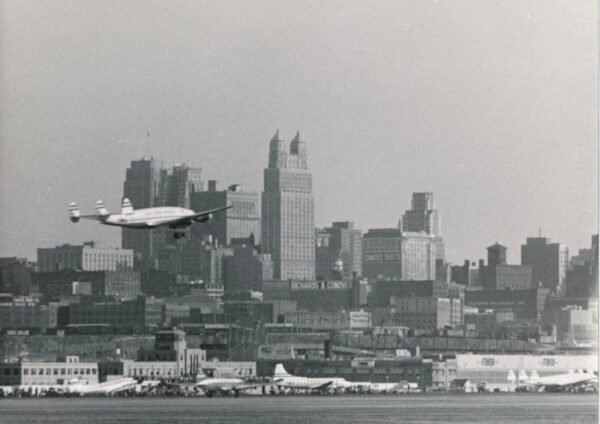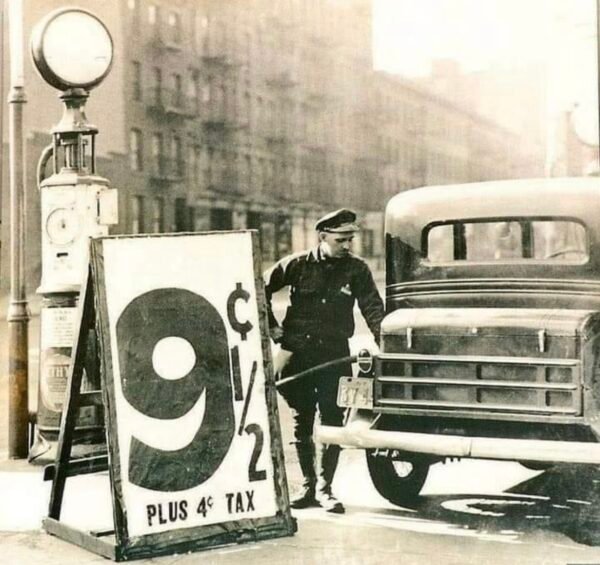Imagine stepping back in time to a packed Yankee Stadium in 1948. The air is electric, buzzing with anticipation and a touch of melancholy. This isn’t just any game; it’s the moment when Babe Ruth, the Sultan of Swat, the guy who changed baseball forever, says his goodbyes. Picture him there, standing tall, bat in hand, as if he’s about to knock another one out of the park, only this time, he’s swinging at our heartstrings. That day wasn’t just a farewell; it was the end of an era and the cementing of a legacy that’s as massive as one of his legendary home runs.
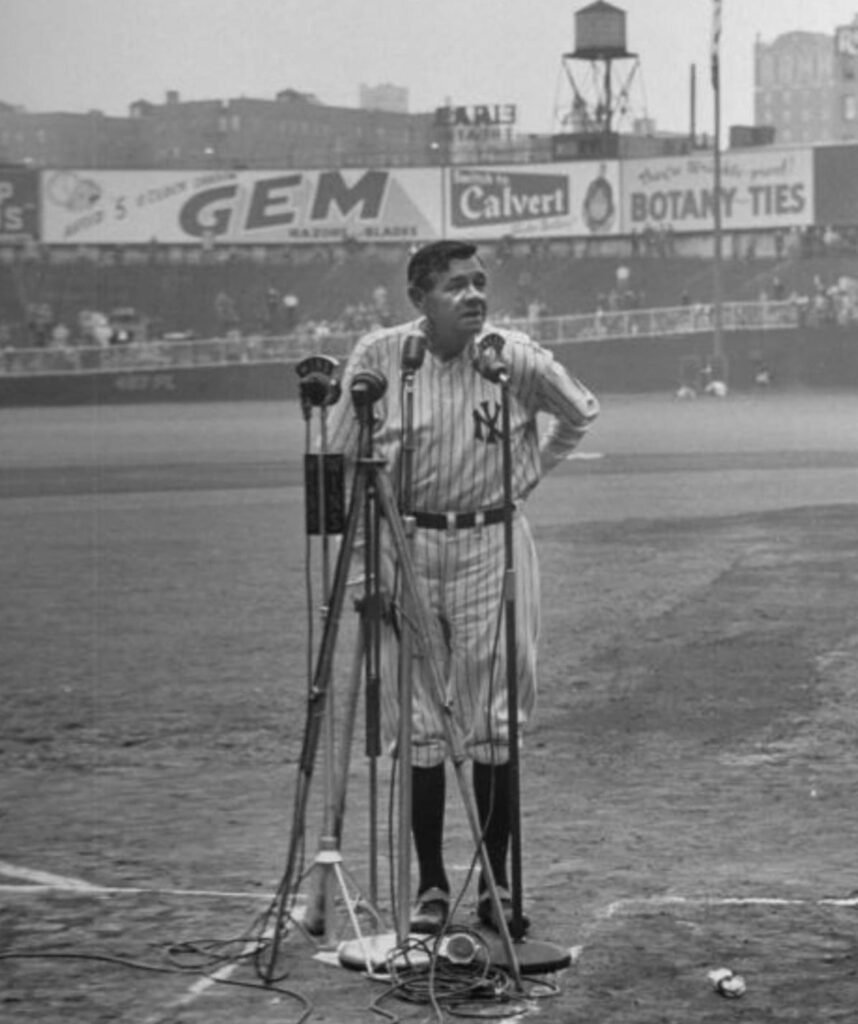
Babe Ruth, this larger-than-life figure, was more than just a baseball player; he was a chapter in the American story. From hitting homers that left fans in awe to living a life that seemed straight out of a tall tale, Ruth was the kind of character you might think someone made up. But oh, was he real. His journey from a kid with a knack for trouble to the king of the ballpark is the stuff of legend, a testament to what passion, raw talent, and a bit of swagger can do.
So, why focus on that speech in ’48? Because it was Babe Ruth standing there, not just as the home run king, but as a symbol of the game’s golden age, saying, “Thanks for the memories,” in the most Ruthian way possible. It’s a moment that captures everything Ruth was about: love for the game, gratitude to the fans, and a reminder of how one man can leave an indelible mark on a sport and a nation.
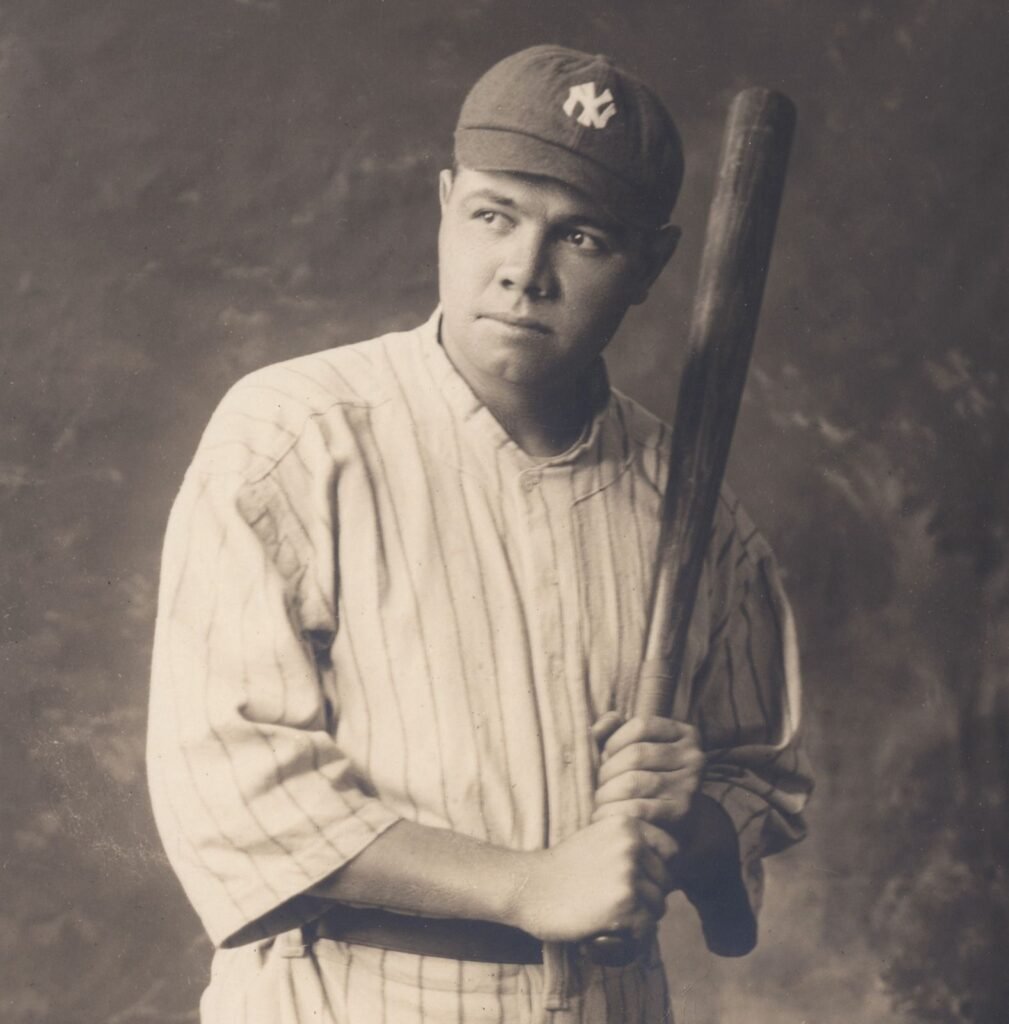
Who Was Babe Ruth?
Let’s wind the clock back and dig into who George Herman “Babe” Ruth really was. Born into a world far removed from the glitz of Yankee Stadium, in Baltimore, 1895, Ruth’s story is a classic tale of rags to baseball riches. This guy didn’t have an easy start. Picture him: a kid from the docks, getting into trouble, with a raw, almost untamed talent for the game. It was at St. Mary’s Industrial School for Boys where he first started to shape that talent, under the guidance of Brother Matthias. It’s one of those pivotal moments in history — like when a band finds its sound or an inventor has their ‘eureka’ moment.
Ruth wasn’t just a player; he was a baseball revolutionary. Moving from the Boston Red Sox to the New York Yankees, he transformed not only his career but the entire sport. Before Ruth, baseball was a game of strategy, bunts, and stolen bases. Then comes Babe, swinging for the fences, making the home run the king of baseball feats and turning the game into the spectacle we love today.
But Ruth’s story is more than just baseball. It’s about the American Dream in the flesh — a kid from the streets making it big and changing the game forever. His larger-than-life personality, his love for the fans, and his off-the-field antics made him a folk hero. Sure, he hit 714 home runs, but he also lived life with a zest and joy that made him relatable. Ruth wasn’t just a player you cheered for; he was the guy you wanted to have a beer with — the ultimate symbol of how baseball is intertwined with the fabric of America.
His impact goes beyond the stats and the records. Ruth showed us what it means to truly love what you do and to give it your all, every time you step up to the plate. He transformed Yankee Stadium from just another ballpark into “The House That Ruth Built,” not just with his bat, but with his heart.
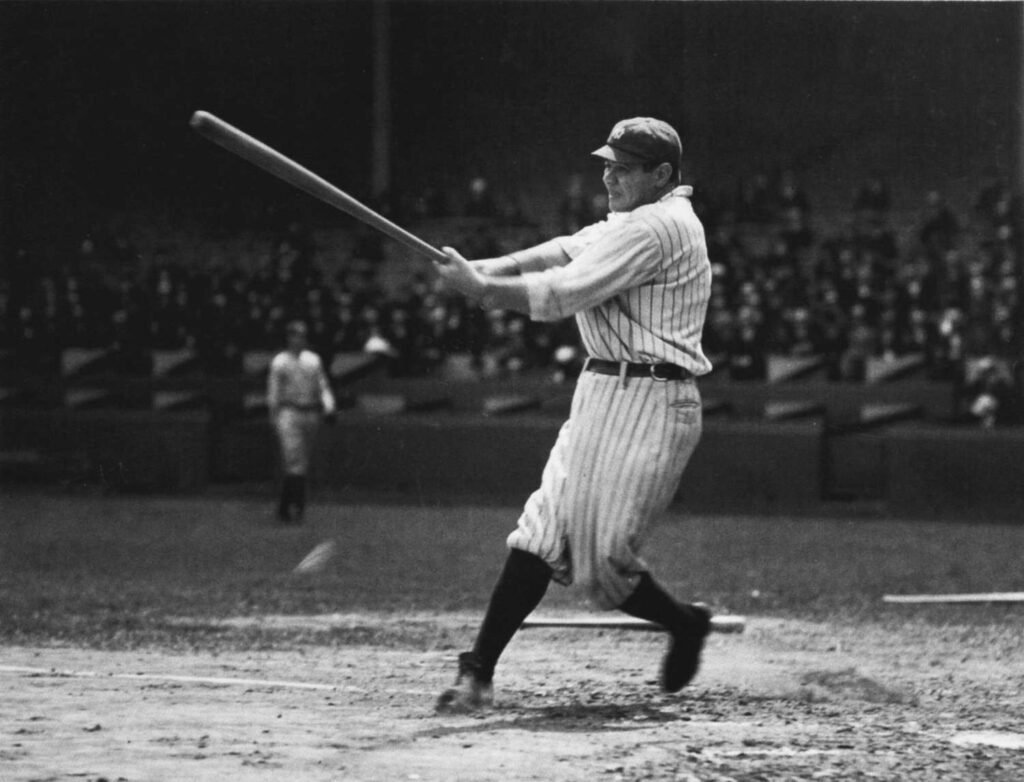
The Context of Babe Ruth’s Final Speech at Yankee Stadium in 1948
By 1948, Babe Ruth had become more than just a baseball player; he was an American icon, a name that resonated in the hearts of millions, echoing the joy and nostalgia of a simpler, yet profoundly significant era in American history. It was a time when heroes were larger than life, and none was bigger than Ruth himself. This was the backdrop against which the Great Bambino made his final appearance at Yankee Stadium, a moment as historic as it was emotional.
The year 1948 wasn’t just significant for Ruth or baseball; it marked a period of transition for America. Post-World War II, the nation was in a state of reconstruction, not just physically but emotionally. The bravery and sacrifice of those who served, reminiscent of the heroic tales captured in “The Boats of WWII”, were still fresh in the collective memory of the American people. In this context, Ruth’s farewell spoke to a nation rebuilding itself, seeking comfort in familiar pastimes and heroes who had brought them joy during times of hardship.
As Ruth stood there, in the “House That Ruth Built,” his speech was more than just words; it was a symbol of the enduring spirit of America. He was frail, battling the cancer that would soon take his life, yet his presence was as commanding as ever. This moment was a poignant reminder of the transience of greatness and the enduring legacy of those who’ve left an indelible mark on history.
Just as the country was moving forward, embracing the changes of the post-war era, so too was baseball. The sport was on the cusp of integration, with Jackie Robinson breaking the color barrier just a year before, in 1947. Ruth’s farewell was a bridge between two eras – one of personal heroics and another of collective progress.
In his speech, Ruth didn’t just reflect on his own career; he acknowledged the fans, the city of New York, and the game of baseball itself. He understood that his achievements were not just his own but belonged to everyone who had ever cheered for a home run, who had ever found joy in the game. This moment, rich in emotion and history, was a testament to the power of sports to unite, to heal, and to inspire.
As we look back on that day in 1948, we’re reminded of the complexity and beauty of Babe Ruth’s legacy. It wasn’t just about the records or the fame; it was about the joy he brought to countless fans and the impact he had on the game he loved. In his final speech, Ruth encapsulated the essence of what it means to be a legend, not just through his words, but through the legacy he left behind.
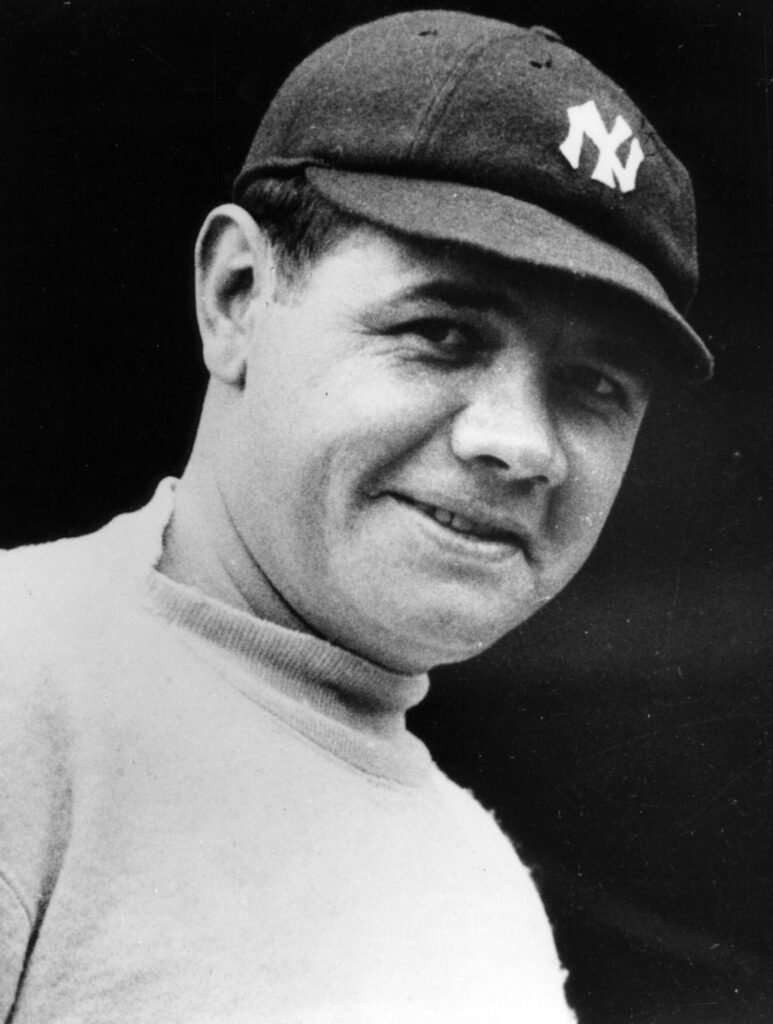
How Did Babe Ruth Change Baseball?
Before Babe Ruth stepped onto the scene, baseball was a game of strategy, speed, and finesse. Think hit-and-run, bunts, and stolen bases. Then along came Ruth, swinging his bat like it was Excalibur, and transformed baseball into a power game, fundamentally changing how it was played and perceived by fans across the nation.
Ruth’s approach to baseball was revolutionary. He didn’t just hit more home runs than anyone else; he made the home run the most thrilling and game-changing aspect of baseball. Before Ruth, a home run was a rarity, something to be celebrated but not expected. Ruth turned them into a spectacle, a display of power and skill that brought fans to their feet and kept them coming back for more. This wasn’t just a shift in strategy; it was a shift in the culture of the sport.
His influence extended beyond the diamond. Ruth became baseball’s first true superstar, elevating the status of professional athletes in American society. In an era before television, his charisma and talent made headlines, filled stadiums, and captivated the nation. Ruth wasn’t just a player; he was a phenomenon, drawing crowds wherever he went, from exhibition games to barnstorming tours.
Moreover, Ruth’s emergence coincided with the Roaring Twenties, a time of economic prosperity and cultural transformation in the United States. In this context, Ruth embodied the American Dream, rising from humble beginnings to achieve unparalleled success. He became a symbol of hope and possibility, demonstrating that with talent and determination, one could ascend to heights previously unimaginable.
Ruth also played a pivotal role in popularizing baseball across the country. His larger-than-life persona and remarkable feats on the field helped turn baseball into the national pastime, a unifying force that brought Americans together, regardless of their background or social status. In doing so, he helped bridge divides, fostering a sense of community and shared identity among fans.
His legacy is not just in the records he set or the games he won, but in how he transformed baseball into a symbol of American culture and identity. Ruth showed that baseball was more than a game; it was a spectacle, a source of drama and excitement, and ultimately, a reflection of the country’s spirit.
In essence, Babe Ruth didn’t just change how baseball was played; he changed how it was understood and loved by the American public. He made baseball bigger, bolder, and more captivating, laying the foundation for the modern game and ensuring his place in the heart of American culture forever.
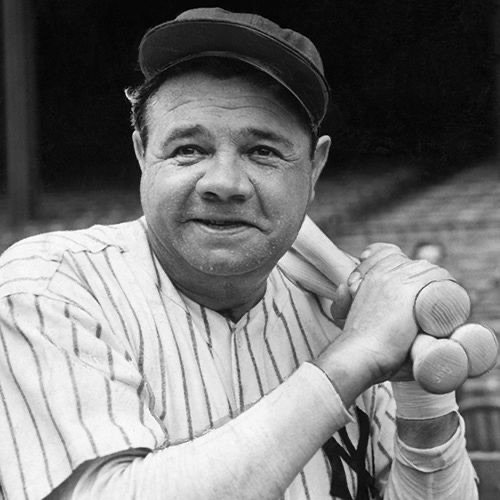
Babe Ruth’s Career by the Numbers
Babe Ruth’s statistics aren’t just impressive; they’re the stuff of legend. When you dive into the numbers, you get a sense of just how dominant Ruth was during his era and how he remains one of the greatest to ever play the game. So, let’s break down the Babe’s career through the lens of his remarkable stats.
Home Runs
- 714 Home Runs: Ruth retired with 714 home runs, a record that stood until Hank Aaron broke it in 1974. This total still ranks him among the all-time leaders, a testament to his power-hitting ability.
Batting Average
- .342 Career Batting Average: Ruth’s ability to hit for average was just as impressive as his power. A career average of .342 places him among the best hitters in baseball history, showcasing his all-around batting skills.
RBIs and Runs Scored
- 2,214 RBIs: Ruth’s runs-batted-in total reflects his capacity to drive in runs, consistently contributing to his team’s offensive output.
- 2,174 Runs Scored: He crossed home plate over two thousand times himself, demonstrating his ability to contribute to his team’s success both by hitting home runs and by getting on base in other ways.
Slugging Percentage
- .690 Career Slugging Percentage: This stat, perhaps more than any other, encapsulates Ruth’s dominance. It measures the total number of bases a player records per at-bat, and Ruth’s .690 remains the highest career slugging percentage in baseball history.
On-Base Plus Slugging (OPS)
- 1.164 OPS: This metric combines a player’s on-base percentage and their slugging percentage to provide a comprehensive view of their offensive value. Ruth’s OPS is unrivaled, further cementing his status as one of the game’s greatest hitters.
Pitching Records
- 94 Wins as a Pitcher: Before becoming an outfielder, Ruth was a successful pitcher, mostly with the Boston Red Sox. His pitching record includes a 2.28 ERA and 107 complete games, highlighting his versatility and athletic prowess.
Historic Moments
- First player to hit 60 home runs in a single season (1927): This achievement was a monumental feat at the time and remained the single-season record until Roger Maris hit 61 in 1961.
- Seven-time World Series champion: Ruth won three titles with the Boston Red Sox and four with the New York Yankees, playing a pivotal role in each championship.
Ruth’s stats paint a picture of a player who was not just a power hitter but a well-rounded baseball talent. His records have become benchmarks by which future generations are measured, and his influence on the game’s offensive strategies can still be felt today. Beyond the numbers, Ruth’s charisma and larger-than-life persona contributed to his lasting legacy, making him a central figure in the narrative of American sports.
As an Amazon Associate we earn from qualifying purchases through some links in our articles.



